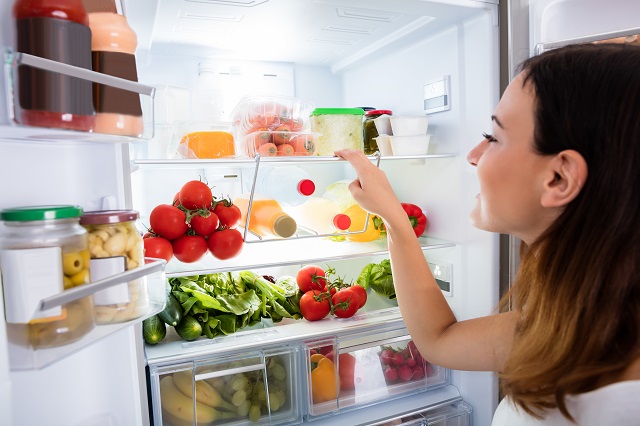
Food safety is an important issue that everyone should take seriously. Improper handling of food puts everyone at risk, particularly infants and children, pregnant women, individuals who have a chronic illness, and the elderly. A kitchen’s layout and organization can help or hinder proper food storage and safety, and this should be taken into account when updating or designing a new kitchen. Whether you’re reorganizing your kitchen yourself or hiring a kitchen remodeler, a primary goal should be to create a space that’s efficient and conducive to safety.
To ensure food safety, food should not come into contact with contaminants including chemicals such as pesticides and cleaning agents in the kitchen. It’s also key to limit the risk of exposure to biological contaminants including bacteria, parasites, and other microorganisms. Of these, bacteria often pose the greatest food safety problem. Bacteria can cause food poisoning or spoilage, and they can spread quickly if not kept in check: In less than a day, billions of bacteria can develop from a single bacterium under the right conditions.
Food may also be exposed to contaminants through cross-contamination. With attention to proper kitchen organization and food handling practices, the odds of illness can be greatly reduced.
Food Product Dating
The date on food products that indicates its age, freshness, or shelf life appears on the label or directly on the product itself. “Best if Used By” or “Expiration Date” are common labels used along with these dates. Some products will use open dating, which shows the date on which a product’s quality may be compromised. Others will use closed dating, which shows the item’s production date and time. Understanding product food dating helps people take proper precautions to keep their perishables safe to consume:
- Expiration dates indicate the last date on which a food item should be eaten.
- The sell-by and use-by dates on food products are meant to indicate quality and not safety, according to the USDA, and many foods may be consumed after this date passes. This does not include infant formula, which should be discarded as soon as it reaches the use-by date.
- Food product dates are not federally regulated.
- Fresh meats and perishable goods can be kept in the freezer and safely cooked and eaten after the expiration date has passed.
- Keeping a marker or label-maker in the kitchen to mark when foods are frozen, purchased, or opened can help people keep track of perishables.
- Items with the earliest dates on them should be stored in the front of cabinets and pantries so as to be used first.
Canned/Shelf-Stable Food Storage and Handling
Shelf-stable foods are those that will not spoil at room temperature. They have typically been treated using heat or drying techniques to destroy harmful organisms. These include items such as flour, sugar, and bottled water. Canned foods are often considered shelf-stable, but this is not always the case: For instance, some types of canned ham do require refrigeration. Always check the label before storing canned items without refrigeration. While shelf-stable foods are generally easy to store safely, there are some things to keep in mind:
- Store shelf-stable foods in a dark location where the temperature is neither overly hot or freezing, ideally between 50 and 70 degrees Fahrenheit.
- Do not store shelf-stable and canned foods in areas that tend to be damp.
- Keep ingredients such as brown sugar fresh by removing them from their original packaging and putting them in airtight, see-through containers.
- Before buying or storing canned foods, check them for signs of rust and corrosion that can lead to spoilage.
- Avoid eating food from cans that are extremely dented or bulging.
- Keep cornmeal and whole-wheat flour from going rancid by keeping them in a sealed freezer bag in the freezer.
Refrigerator Storage Order
In most kitchens, the refrigerator is one of the most widely used places for food storage. But it isn’t enough to simply place food in the refrigerator and keep it cold. Foods should be arranged a certain way to prevent problems such as cross-contamination:
- Keep cooked foods such as leftovers and other ready-to-be-eaten items on the upper shelves in the refrigerator.
- Store meat below cooked foods that are ready to eat.
- Poultry items should be stored on the lower shelves in the refrigerator.
- Raw poultry, meat, or fish should be sectioned off and stored on the bottom shelves on a plate or in a bin to prevent the spread of bacteria.
- Eggs and dairy items should be kept near the back of the refrigerator, where it’s the coldest, and not on the door.
- Fruits and veggies should be kept separate in the crisper.
Food Preparation and Cooking Tips
When preparing and cooking food, it’s important to handle it properly. Harmful microorganisms are easily spread and can make people sick. This can happen if cooking surfaces and hands are not clean or if the proper cooking temperatures are not reached. By safely preparing and cooking food, problems such as food poisoning can be limited:
- Keep hand soap by the kitchen sink and a clean towel nearby. Always wash hands using warm water and soap before and after handling raw food, including vegetables.
- When thawing out raw meat, place it on the lowest shelf in the refrigerator on a plate to catch any juices.
- Move other food items away from raw food that’s being cut or otherwise handled to prevent splatter and accidental cross-contamination.
- Use cutting boards whenever preparing raw food. Bamboo and non-porous boards made of plastic or acrylic are easiest to clean.
- Dedicate a cutting board specifically for meats and one for vegetables and bread.
- A solution made of 1 gallon of water and 1 tablespoon of bleach can be used to sanitize cutting boards and countertops.
- Keep clean dish towels in a kitchen drawer and replace used ones frequently, as bacteria will grow on damp towels.
- Invest in and use a kitchen thermometer when cooking to ensure that food reaches the appropriate internal temperature for safety.
Additional Resources
- Food Product Dating
- Proper Food Storage Adds to Your Bottom Line
- Separate, Don’t Cross-Contaminate
- Storing Home-Canned Foods
- Are You Storing Food Safely?
- How to Stock and Store Dry Goods, Canned Goods, and Condiments
- Pantry Food Storage
- Storing Meat in Your Refrigerator
- How to Organize Your Fridge to Keep Foods Fresher Longer (and Cut Your Energy Bill)
- Food Safety Tips
 Home Improvements to Prevent Kitchen Fires
Home Improvements to Prevent Kitchen Fires  Home Improvements for Kitchen Safety
Home Improvements for Kitchen Safety  11 Home Security and Safety Tips
11 Home Security and Safety Tips  How Can I Remodel for a Vintage-Style Kitchen?
How Can I Remodel for a Vintage-Style Kitchen?  Best Cities for Sidewalks and Winter Safety
Best Cities for Sidewalks and Winter Safety 

Are You Familiar With This Topic? Share Your Experience.